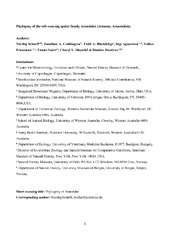Phylogeny of the orb-weaving spider family Araneidae(Araneae: Araneoidea)
Scharff, Nikolaj; Coddington, Jonathan A.; Blackledge, Todd A.; Agnarsson, Ingi; Framenau, Volker W.; Szüts, Tamás; Hayashi, Cheryl Y.; Dimitrov, Dimitar
Peer reviewed, Journal article
Accepted version
Permanent lenke
https://hdl.handle.net/1956/22200Utgivelsesdato
2020Metadata
Vis full innførselSamlinger
Originalversjon
https://doi.org/10.1111/cla.12382Sammendrag
We present a new phylogeny of the spider family Araneidae based on five genes (28S, 18S, COI, H3 and 16S) for 158 taxa, identified and mainly sequenced by us. This includes 25 outgroups and 133 araneid ingroups representing the subfamilies Zygiellinae Simon, 1929, Nephilinae Simon, 1894, and the typical araneids, here informally named the “ARA Clade”. The araneid genera analysed here include roughly 90% of all currently named araneid species. The ARA Clade is the primary focus of this analysis. In taxonomic terms, outgroups comprise 22 genera and 11 families, and the ingroup comprises three Zygiellinae and four Nephilinae genera, and 85 ARA Clade genera (ten new). Within the ARA Clade, we recognize ten informal groups that contain at least three genera each and are supported under Bayesian posterior probabilities (≥ 0.95): “Caerostrines” (Caerostris, Gnolus and Testudinaria), “Micrathenines” (Acacesia, Micrathena, Ocrepeira, Scoloderus and Verrucosa), “Eriophorines” (Acanthepeira, Alpaida, Eriophora, Parawixia and Wagneriana), “Backobourkiines” (Acroaspis, Backobourkia, Carepalxis, Novakiella, Parawixia, Plebs, Singa and three new genera), “Argiopines” (Arachnura, Acusilas, Argiope, Cyrtophora, Gea, Lariniaria and Mecynogea), “Cyrtarachnines” (Aranoethra, Cyrtarachne, Paraplectana, Pasilobus and Poecilopachys), “Mastophorines” (Celaenia, Exechocentrus and Mastophora,), “Nuctenines” (Larinia, Larinioides and Nuctenea), “Zealaraneines” (Colaranea, Cryptaranea, Paralarinia, Zealaranea and two new genera) and “Gasteracanthines” (Augusta, Acrosomoides, Austracantha, Gasteracantha, Isoxya, Macracantha, Madacantha, Parmatergus and Thelacantha). Few of these groups are currently corroborated by morphology, behaviour, natural history or biogeography. We also include the large genus Araneus, along with Aculepeira, Agalenatea, Anepsion, Araniella, Cercidia, Chorizopes, Cyclosa, Dolophones, Eriovixia, Eustala, Gibbaranea, Hingstepeira, Hypognatha, Kaira, Larinia, Mangora, Metazygia, Metepeira, Neoscona, Paraplectanoides, Perilla, Poltys, Pycnacantha, Spilasma and Telaprocera, but the placement of these genera was generally ambiguous, except for Paraplectanoides, which is strongly supported as sister to traditional Nephilinae. Araneus, Argiope, Eriophora and Larinia are polyphyletic, Araneus implying nine new taxa of genus rank, and Eriophora and Larinia two each. In Araneus and Eriophora, polyphyly was usually due to north temperate generic concepts being used as dumping grounds for species from southern hemisphere regions, e.g. South‐East Asia, Australia or New Zealand. Although Araneidae is one of the better studied spider families, too little natural history and/or morphological data are available across these terminals to draw any strong evolutionary conclusions. However, the classical orb web is reconstructed as plesiomorphic for Araneidae, with a single loss in “cyrtarachnines”–“mastophorines”. Web decorations (collectively known as stabilimenta) evolved perhaps five times. Sexual dimorphism generally results from female body size increase with few exceptions; dimorphic taxa are not monophyletic and revert to monomorphism in a few cases.
